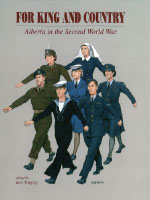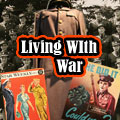Der Deutsche Kriegsgefangener auf Alberta*:
Alberta and the Keeping of German Prisoners of War, 1939-1947
*The German title is "German Prisoners of War in Alberta."
John Joseph Kelly
Reprinted with permission of the author and publisher of For King and Country: Alberta in the Second World War Even though prisoners were labouring on these projects, and the government was able to save money by utilizing them, neither side forgot that these were combatant prisoners whose duty was to escape from Canada and return to Germany to fight again. During the war, about a hundred German prisoners made their escapes from Canadian internment authorities, with most such incidents occurring when the German prisoners walked away from labour projects upon which they were employed. In November 1946 there were still some 23 German prisoners "at large", eighteen months after the cessation of hostilities. At the Medicine Hat camp, the authorities found a homemade short wave radio, with the radio antenna threaded through the clothesline. There was a short wave radio at the Lethbridge camp as well; until May 1945 this set was completely portable, and was moved from hut to hut. However, it was not very efficient, and only occasionally would it pick up German stations. To compensate for this shortcoming, a larger set was built by three prisoners, and was assembled inside a building partition in the music instrument repair shop. The parts came from men who had been on the outside on labour projects, and all the parts were "home-made". For example, the tuning knobs were made from the tops of Listerine bottles, while the headphones were taken from German air force helmets.23 Messages would be smuggled into camps, written in indelible pencil on wax paper, in nutshells, in sausages, in cigars, and in tin cans. In one case at Lethbridge, in October 1944, a letter was sent to the camp inside a loaf of bread, which was detected only when the loaf was sawed through by the camp authorities. The information had been allowed through by the German censors in the hope that it would get through to the prisoners. However, the war news was so bad from Germany that the camp authorities let it through to demoralize the prisoners even more. Camp authorities also found a home-made air rifle at Medicine Hat, instruments rigged up for low-power high voltage electric charges, short wave radio antennae made from bedsprings, and even explosive belts! A search at the Medicine Hat camp during September 1944 also turned up "secret writing" materials, as well as complete directions from Germany as to their use and purpose. This kit included a solid type of ink that had previously only been used by the German Secret Service. It seemed obvious to the camp authorities that an extensive organization had been set up in Germany to make use of intelligence information gathered by the prisoners.
Even though prisoners were labouring on these projects, and the government was able to save money by utilizing them, neither side forgot that these were combatant prisoners whose duty was to escape from Canada and return to Germany to fight again. During the war, about a hundred German prisoners made their escapes from Canadian internment authorities, with most such incidents occurring when the German prisoners walked away from labour projects upon which they were employed. In November 1946 there were still some 23 German prisoners "at large", eighteen months after the cessation of hostilities. At the Medicine Hat camp, the authorities found a homemade short wave radio, with the radio antenna threaded through the clothesline. There was a short wave radio at the Lethbridge camp as well; until May 1945 this set was completely portable, and was moved from hut to hut. However, it was not very efficient, and only occasionally would it pick up German stations. To compensate for this shortcoming, a larger set was built by three prisoners, and was assembled inside a building partition in the music instrument repair shop. The parts came from men who had been on the outside on labour projects, and all the parts were "home-made". For example, the tuning knobs were made from the tops of Listerine bottles, while the headphones were taken from German air force helmets.23 Messages would be smuggled into camps, written in indelible pencil on wax paper, in nutshells, in sausages, in cigars, and in tin cans. In one case at Lethbridge, in October 1944, a letter was sent to the camp inside a loaf of bread, which was detected only when the loaf was sawed through by the camp authorities. The information had been allowed through by the German censors in the hope that it would get through to the prisoners. However, the war news was so bad from Germany that the camp authorities let it through to demoralize the prisoners even more. Camp authorities also found a home-made air rifle at Medicine Hat, instruments rigged up for low-power high voltage electric charges, short wave radio antennae made from bedsprings, and even explosive belts! A search at the Medicine Hat camp during September 1944 also turned up "secret writing" materials, as well as complete directions from Germany as to their use and purpose. This kit included a solid type of ink that had previously only been used by the German Secret Service. It seemed obvious to the camp authorities that an extensive organization had been set up in Germany to make use of intelligence information gathered by the prisoners.
The Canadian authorities had a great fear of a "Gestapo element" in the camps, and this fear was confirmed with the murders of German prisoners at the Medicine Hat camp on two occasions: 22 July 1943, and 10 September 1944. In the first case, the murder of August Plaszek, a Military Court of Inquiry noted:
.... The guilty party or parties were not discovered, but a good many P. W., strongly Nazi, who either assisted in, connived at, or approved of the hanging, were uncovered. Some of these, all strongly Nazi and some Gestapo, had been troublemakers at Lethbridge and Ozada, and it is evident that they were anxious to get control of the camp from the slightly more moderate Nazi group previously in control.24
An Intelligence Report, gathered from the scrapbook of a German POW, backs up the assessment of the Court of Inquiry:
.... And now, a little "Gestapo" has also come into existence, which sternly saw to it that all the soldiers of the camp behaved as exemplary Nazis .... Some P. W. were tired of being duped any more by these uniformed tramps and got together to bring about an overthrow of these elements. But through treachery, the camp police got wind of this, and a few of those revolutionists had to leave the camp. The mob got hold of one of them, dragged him into the recreation hut, and strung him up on one of the rafters here without any trial whatever, after he had first been stoned half to death.. Thus did Gefreiter Plaszek, having done his duty towards the Fatherland at the front, die the hero's death.25
In the second case, Karl Lehmann was dragged into the classroom where he had taught French language classes to some of his fellow prisoners. Here, the best boxer in the camp struck Lehmann once on the jaw, injuring him and causing him to bleed. Then they hanged him from a gas pipe in a corner of the room, where his body was not found until the next morning.26 The authorities spoke of a "Geistige Betreung" [Spiritual guardianship], which had both a "spiritual" control over the hearts of the prisoners, and a Gestapo control over the prisoners' minds, exercised through education in the camps, political censorship, morale and ideology.27 Throughout the last few years of the war prisoners were constantly seeking the protection of the Canadian authorities, and there appears to have been some truth to the military assessment that:
.... a group of P. W .... were trying to maintain Nazi doctrines among the P. W., and there was a lot of talk about organizing a "Werewolf" organization .. They were transferred to Neys on April l S, 1945, and things calmed down ....28
With the war winding down the Canadian government did not see fit to accept any more prisoners from Britain, though the British requested that Canada accommodate another fifty thousand prisoners.29 The Canadian government felt that with the prisoners it was already holding, it was more important to classify them by their degrees of pro- and anti-Nazi fervour, in order to facilitate their ultimate repatriation back to Germany. It was felt that no prisoners would be returned until after the end of the military occupation of Germany, which would be at least] 112 years after the cessation of hostilities. The PHERUDA programme was established in each camp, and classified prisoners as being "Black" [strong Nazi], "White" [anti-Nazi], or "Grey" [neutral or moderate]. This was done on the basis of interrogating prisoners about their political leanings, their attitude towards Hitler, their education, their religion, their usefulness for the purposes of labour, their dependability, and their attitude [rated from pro-Allied to anti-Allied]. The basic test of "whiteness" was the willingness of the prisoner to cooperate with the Canadian authorities in different ways. The Whites were to be repatriated first, the Greys second, and the Blacks were to be sent back to the defeated Fatherland last of all.
Notes
23. NAC, RG 24, Microfilm Reel C-5416, Colonel E.D.B. Kippen to Headquarters of MD #3, 27 September 1945.
24. NAC, Directorate of Prisoners of War, File H.Q.S. 7236, “Case of hanging by his fellow prisoners of P.W. Sdt. PLASZEK, August.”
25. NAC, Directorate of Prisoners of War, Intelligence Report, File 26-H-44, 14 November 1944.
26. Douglas Sagi, “My Fuehrer I Follow Thee” The Canadian Magazine, 4 January 1975, pp. 1-4.
27. NAC, RG24, Microfilm Reel C-5365, Camp Intelligence at Lethbridge, Colonel E.D.B. Kippen to Headquarters MD 13, 2 April 1945.
28. NAC, RG24, Microfilm Reel C-5365, Camp Intelligence at Lethbridge, Intelligence Report for April 1945, 11 May 1945.
29. NAC, Minutes of the Cabinet War Committee, RG2, 7c, Vol. 16, Meeting of Monday 11 December 1944.








